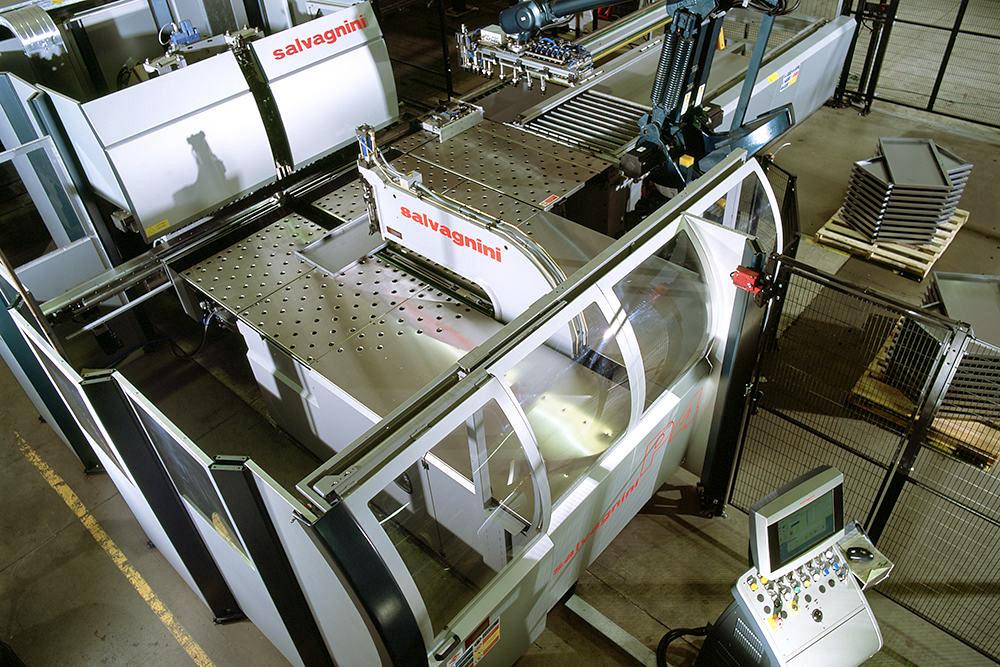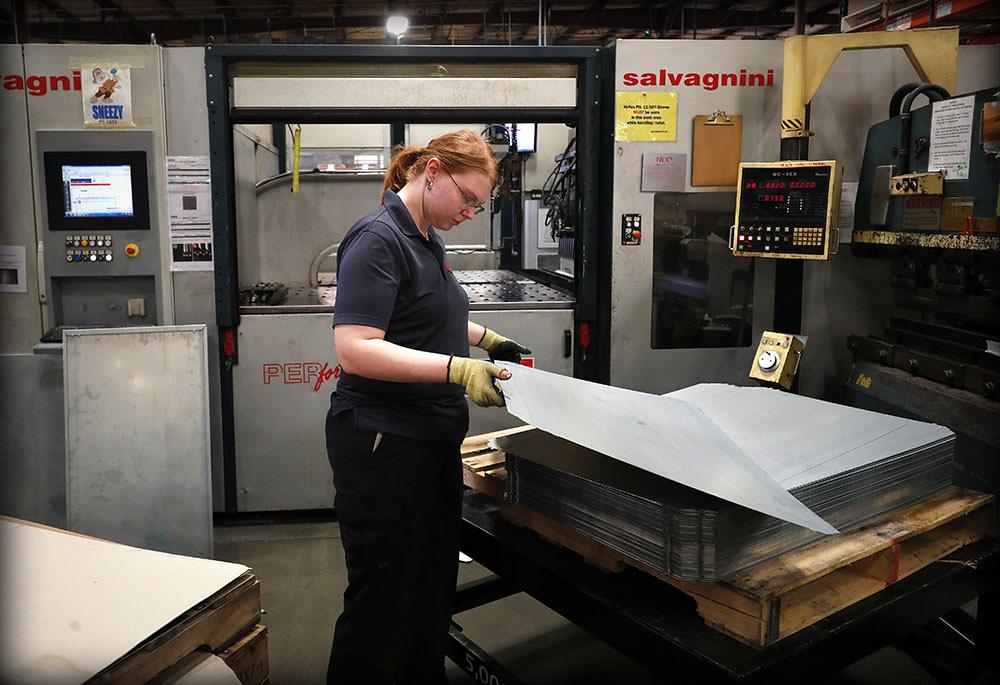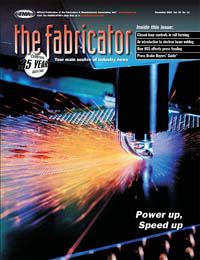- FMA
- The Fabricator
- FABTECH
- Canadian Metalworking
Categories
- Additive Manufacturing
- Aluminum Welding
- Arc Welding
- Assembly and Joining
- Automation and Robotics
- Bending and Forming
- Consumables
- Cutting and Weld Prep
- Electric Vehicles
- En Español
- Finishing
- Hydroforming
- Laser Cutting
- Laser Welding
- Machining
- Manufacturing Software
- Materials Handling
- Metals/Materials
- Oxyfuel Cutting
- Plasma Cutting
- Power Tools
- Punching and Other Holemaking
- Roll Forming
- Safety
- Sawing
- Shearing
- Shop Management
- Testing and Measuring
- Tube and Pipe Fabrication
- Tube and Pipe Production
- Waterjet Cutting
Industry Directory
Webcasts
Podcasts
FAB 40
Advertise
Subscribe
Account Login
Search
Fast-forward fabricating
Automation helps Estes Design and Manufacturing turn around jobs quickly
- December 13, 2005
- Article
- Materials Handling
A day in the life of a fabricator doesn't follow a script. It's improvisation at its finest. Estes Design and Manufacturing of Indianapolis can attest to that. The 81-employee contract fabricator routinely responds at a moment's notice to its customers' urgent pleas for help.
Ron Estes, the company's vice president of operations, shared the wham-bam, help-them-out-of-a-jam tale of one recent fabricating job.
A Day in the Life ...
8 a.m. An office furniture manufacturer has experienced a tool failure. The company is looking at either shutting down a production line and sending everyone home or finding someone to fabricate the parts needed for the final assemblies while the needed repairs take place. The first call goes to Estes because the contract manufacturer is already fabricating other metal parts for the office furniture OEM.
"So they asked us if we could ramp up very quickly to produce a family of parts," Estes said.
Estes is not too concerned about his company's ability to turn around the job in a timely manner. First, his company has developed a reputation for making on-time deliveries of jobs ranging from 10 to 5,000 parts. Second, in 2004 the company installed a 150-shelf MV3000 automatic retrieval and storage system from Salvagnini America Inc. As the material handling and storage system was installed, it was also integrated with several other pieces of Salvagnini equipment:
- Two S4 CNC shear/punch cells, purchased in the 1990s, with 30-ton capacity and capable of accommodating 60-inch by 120-in. sheets of steel (up to 10 gauge), stainless steel (up to 14 ga.), and aluminum (up to 0.2 in.).
- A new L2 Lightning CNC laser cutting machine capable of cutting 60-in. by 120-in. sheets of steel (0.5 in. maximum), stainless steel (0.375 in.), and aluminum (0.25 in.).
- A new P4 CNC panel bender with a 72.8-in. bend length, a 59.1-in. blank width, an 84.6-in. blank diagonal, and a 5-in. bend height. The panel bender with a loading/unloading robot can handle up to 14-ga. steel, 18-ga. stainless steel, and 0.1-in. aluminum sheet.
10:30 a.m. Estes Design and Manufacturing's computer-aided design (CAD) department receives an e-mail of the customer's part drawings. The drawings cover a family of eight office furniture parts.
Using tools such as Pro/Engineer Wildfire and AutoCAD® 2000, Estes programmers flatten the 3-D part drawings, creating accurate, flat forms of the parts. The software automatically compensates for the plastic deformation of metal that occurs during bending.
The programmers then rely on Salvagnini's proprietary MetalNest software to plan the most efficient nesting configuration, sequence of machine operations, and machine programming to produce the parts. The job is ready to run.
1 p.m. The rush job is assigned to the Salvagnini flexible manufacturing cell. The three operators at work in the cell download the first of the programs over the shop's local-area network, and the automatic storage and retrieval system delivers the appropriate sheets to the laser and punch/shears.
2 p.m. The machines complete previously scheduled tasks and immediately launch into production of blanks for the faceplate of a metal drawer. Because they are too small for the panel bender in the cell, the cut blanks are transferred to one of three stand-alone panel benders where the finished parts are produced.
After a worker transfers a stack of blanks to a semiautomatic Salvagnini Performer panel bender, the operator has the machine begin folding the edges, making two bends on each side.
7 p.m. The shop ships 341 completed drawer fronts. Over the next 13 business days, Estes Design and Manufacturing produces and ships a total of 18,577 parts.
Business Not So Usual
During the same month it rushed out the metal fabricated parts for the office furniture application, Estes said his company had another rush job for which his employees shipped parts the same day that they received new part files.
Overall, turnaround time has sped up. In the automated cell's first four months of operation, overall lead-time was reduced by 29 percent over the same period in the previous year.
"We're expecting to see a 50 percent reduction in lead-time when everything is operational and all of the software is integrated," Estes added.
Worker productivity also is expected to increase with the automated cell. Because the automated storage and retrieval system and punching, bending, and laser cutting equipment are able to run without operator attention much of the time, Estes said workers are able to engage in other value-added activities while the machinery is running. The equipment frequently runs through breaks, lunch periods, and shift changes.
"The numbers are pretty staggering," Estes said. "We've seen a 67 percent rise in production hours logged per week in the cell over the first four months. Certainly, some of this increase can be attributed to our operators advancing on the learning curve, but the largest part is a result of their effective use of the automation to improve productivity. In addition to increased throughput, we've also seen nearly a 5 percent increase in revenue per production hour on the four machines in the cell."
Estes said the notion that automation suits only high-volume manufacturing is untrue. His company's automation investments have enabled him to streamline changeovers, reduce the time between operations, and maximize just-in-time inventory control.
As an example he pointed to the P4 panel benders. "In one operation, the panel bender might do work that would have required two or three setups in a press brake," Estes said.
By taking advantage of the technology offerings, operators can contribute to efficiency gains. Operators and programmers can program the panel benders either offline in the CAD department or at the machine while it is working on a different job. In fact, programming new parts or selecting an existing program for a previously run part from the computer's directory is often the only activity required for the P4 ALA panel bender at changeover, Estes said. Once the operator loads the program, the panel bender's tooling configures itself automatically.
Automation, however, doesn't mean the elimination of operators. Operator intervention still is needed in some instances.
Unlike the P4, the Lightning laser and the S4 punch/shear often require more than new programs at changeover. The laser, for example, sometimes needs a different cutting head when it is cutting a different material, such as when the material changes from light-gauge carbon steel to a heavy-gauge aluminum. In these instances, the operator must take a few minutes to change the cutting head and center the nozzle for proper positioning.
To keep the time spent on these tasks to a minimum, the operator looks forward in the job queue to find a number of jobs running the same material and schedules them to run one after the other.
"Once the laser parameters are set for the material, setup and changing from one job to another require very little time," Estes said. "The only thing that the operator must do is verify the first part dimensionally."
Changeovers for the two S4 punch/ shears are similar in that the operators strive to organize jobs into groups that use the same mix of tools.
"We prefer to leave the same tools in the punching head and program the machine to run as many parts as possible from that particular configuration," Estes explained. The goal of running a number of jobs from the same tool set is to reduce setups. When tool changes are unnecessary, operator intervention is limited to loading the programs prior to running the job.
What's Next?
Estes wants to integrate Salvagnini's Opera-OPS part processing and machine scheduling software into the shop's enterprise resource planning software.
"Its implementation will allow us to download our schedule to OPS, which will look at jobs that run from like materials and tool configurations," Estes said. "It will bring those jobs together and even nest different parts for different customers on the same sheet."
Not only will the software generate additional capacity on the equipment by making it more efficient, but it also will increase the flexibility of the cell by optimizing the schedule and accommodating late-coming jobs. Because the shop strives to schedule the automated machines to run at 80 percent of capacity—the percentage figure used for justifying the cell—the balance of the time can be used for routine maintenance or emergency jobs.
"The work load at a contract manufacturer is never at steady state," Estes noted. "It fluctuates.
"In the past when demand surged, with stand-alone manual machines, we could respond either with overtime or by hiring additional people. Neither was a good fix," he added. "The automation gives us the means of flexing capacity with minimal effect on manpower requirements."
The automation helps the improvisation routine at Estes Design and Manufacturing from being a joke.
Related Companies
subscribe now

The Fabricator is North America's leading magazine for the metal forming and fabricating industry. The magazine delivers the news, technical articles, and case histories that enable fabricators to do their jobs more efficiently. The Fabricator has served the industry since 1970.
start your free subscription- Stay connected from anywhere

Easily access valuable industry resources now with full access to the digital edition of The Fabricator.

Easily access valuable industry resources now with full access to the digital edition of The Welder.

Easily access valuable industry resources now with full access to the digital edition of The Tube and Pipe Journal.
- Podcasting
- Podcast:
- The Fabricator Podcast
- Published:
- 04/16/2024
- Running Time:
- 63:29
In this episode of The Fabricator Podcast, Caleb Chamberlain, co-founder and CEO of OSH Cut, discusses his company’s...
- Trending Articles
Capturing, recording equipment inspection data for FMEA

Tips for creating sheet metal tubes with perforations

Are two heads better than one in fiber laser cutting?

Supporting the metal fabricating industry through FMA

Omco Solar opens second Alabama manufacturing facility

- Industry Events
16th Annual Safety Conference
- April 30 - May 1, 2024
- Elgin,
Pipe and Tube Conference
- May 21 - 22, 2024
- Omaha, NE
World-Class Roll Forming Workshop
- June 5 - 6, 2024
- Louisville, KY
Advanced Laser Application Workshop
- June 25 - 27, 2024
- Novi, MI




























